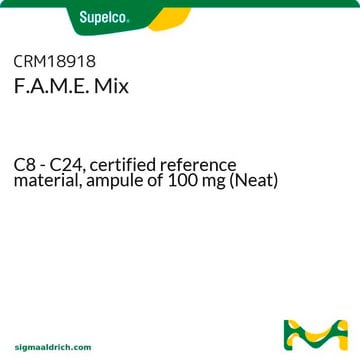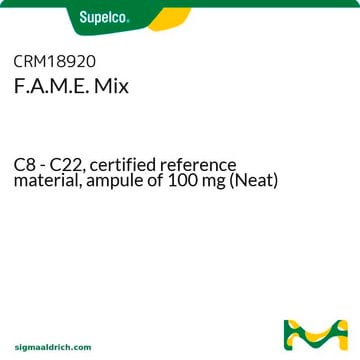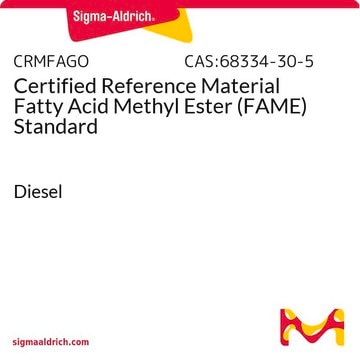SMB00937
Fatty Acid Methyl Esters Standard Mixture
Synonym(s):
FAME, fatty acids, standard mixture
About This Item
Recommended Products
form
liquid
Quality Level
packaging
pkg of 1 vial
solubility
soluble, clear, colorless
storage temp.
-10 to -25°C
Related Categories
General description
Application
Gas chromatography-mass spectrometry (GC-MS)-based metabolomics is used to identify and quantify small-molecule metabolites such as small acids, alcohols, hydroxyl acids, amino acids, sugars, fatty acids, sterols, catecholamines, drugs, and toxins.
Fatty acid methyl esters used in this standard showed a strong, consistent m/z 87 ion and molecular ions which could be used to differentiate the individual peaks.
Other Notes
Analyte
Signal Word
Danger
Hazard Statements
Precautionary Statements
Hazard Classifications
Acute Tox. 3 Inhalation - Acute Tox. 4 Oral - Carc. 2 - Eye Irrit. 2 - Repr. 2 - Skin Irrit. 2 - STOT RE 1 Oral - STOT SE 3
Target Organs
Central nervous system, Liver,Kidney
Storage Class Code
6.1D - Non-combustible acute toxic Cat.3 / toxic hazardous materials or hazardous materials causing chronic effects
WGK
WGK 3
Flash Point(F)
Not applicable
Flash Point(C)
Not applicable
Choose from one of the most recent versions:
Certificates of Analysis (COA)
Don't see the Right Version?
If you require a particular version, you can look up a specific certificate by the Lot or Batch number.
Already Own This Product?
Find documentation for the products that you have recently purchased in the Document Library.
Our team of scientists has experience in all areas of research including Life Science, Material Science, Chemical Synthesis, Chromatography, Analytical and many others.
Contact Technical Service






